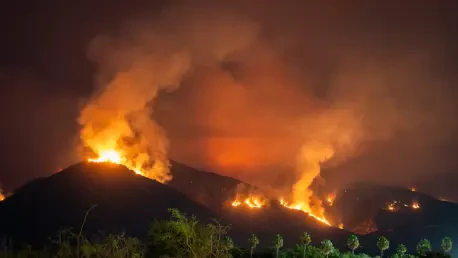A new partnership between the Oregon State Fire Marshal and the Insurance Institute for Business and Home Safety is poised to benefit Oregonians by offering solutions to increase resilience against wildfires. This collaboration, established through a memorandum of agreement, is designed to help homeowners implement preventive measures, which could subsequently reduce property insurance costs. This initiative addresses a pressing need for homeowners seeking to safeguard their properties amidst a rising incidence of wildfires. With property insurance costs escalating by 30%, Oregon aims to replicate California’s success in incentivizing wildfire mitigation measures while maintaining a robust insurance market. The introduction of the “Wildfire Prepared” certification provides a well-structured approach to wildfire prevention. It ensures that Oregon homeowners not only emphasize fireproofing their properties but also secure affordable and continuous coverage. The state’s proactive stance marks a significant shift toward collaboration with the insurance sector, aiming to create a sustainable environment for both homeowners and insurers.
1. Clear Zone Creation
Creating a defensible space around homes is an essential first step in minimizing wildfire risks and improving safety. This initiative mandates a meticulous inspection of the immediate surroundings of residences to eliminate any potential fire hazards that might compromise the integrity of the property. A dedicated 5-foot buffer zone surrounding a home and any attached decks must be devoid of any combustible materials. This entails the removal of trees, branches, mulch, grass, turf, and even wooden or vinyl fencing. By ensuring that these items are not in proximity to the structure, homeowners significantly reduce the risk of fire reaching or damaging their homes.
Clearing this zone not only protects individual properties but also contributes to community-wide safety and reduces pressure on emergency services during fire events. The concerted effort to maintain this safety perimeter is a testament to the state’s commitment to cultivating fire-resistant communities. By emphasizing the removal of flammable materials, residents increase their resilience and readiness in the face of potential wildfires. The implementation of such precautionary measures is paramount for long-term safety and serves as a cornerstone of the Wildfire Prepared certification program.
2. Submission Process
To participate in the Wildfire Prepared certification program, homeowners must undertake a straightforward yet critical submission process. This process serves to document and validate the completion of the necessary fire prevention improvements around their properties. Once the mandatory work is concluded, applicants are required to submit an application accompanied by a nominal fee of $125. This application should include clear photographic evidence showcasing the comprehensive work carried out to meet the program’s requirements.
The photographic documentation is crucial in assuring that the guidelines for wildfire prevention have been met adequately. This step also provides an opportunity for homeowners to present the extent of modifications and improvements performed. It underscores the significance of visual evidence in confirming compliance with the program’s standards. The submissions are first evaluated by qualified inspectors from the Insurance Institute for Business and Home Safety. This initial evaluation serves to ensure that the key elements of the prevention guidelines have been correctly implemented before proceeding to further assessments.
3. Inspection Phase
After the submission process, the inspection phase plays a pivotal role in confirming the accuracy and thoroughness of homeowners’ efforts to fireproof their properties. Inspectors from the Insurance Institute for Business and Home Safety conduct a comprehensive review of submitted materials, focusing on the effective implementation of wildfire prevention measures. This initial review is critical, as it determines whether the property meets the criteria for the certification program based on the photographic evidence provided.
If the inspectors approve the initial assessment, a third-party assessor visits the property to perform an on-site verification. This verification ensures that all preventive measures are physically in place, as documented. During this visit, the assessor may suggest additional actions if the work performed requires further enhancements to meet the certification standards fully. Through this detailed inspection process, the program reinforces its commitment to maintaining high standards in wildfire preparedness, providing homeowners with actionable feedback to enhance their property’s safety.
4. Annual Maintenance
The Wildfire Prepared certification emphasizes ongoing maintenance to ensure sustained wildfire protection over time. Homeowners are required to demonstrate continual compliance by submitting photographs annually, showcasing the upkeep of their defensible space buffer. This annual maintenance is crucial to preserving the certification status and providing assurance that the prevention measures remain effective against wildfire threats. By maintaining this buffer zone, homeowners contribute to a reduced risk of wildfires causing damage to their properties.
Sustained maintenance practices not only extend the lifespan of fire prevention measures but also fortify the community’s overall resilience to potential wildfire incidents. Consistently maintaining the buffer zone protects the home and contributes positively to the safety of the surrounding neighborhood. Engaging in regular assessments and updates, homeowners confirm their proactive stance in the face of wildfire risks. It symbolizes a commitment to ongoing fire safety standards and underscores the importance of adaptability and vigilance in sustaining long-term property protection.
5. Recertification Requirement
A promising partnership is underway between the Oregon State Fire Marshal and the Insurance Institute for Business and Home Safety, aimed at bolstering wildfire resilience for Oregonians. This collaboration is formalized by a memorandum of agreement and seeks to help homeowners adopt preventive measures, potentially lowering property insurance premiums. As wildfires become increasingly frequent, there’s an urgent demand for ways to protect properties. Property insurance costs in Oregon have surged by 30%, prompting the state to follow California’s lead in encouraging wildfire mitigation while retaining a strong insurance market. The “Wildfire Prepared” certification offers a comprehensive strategy for wildfire prevention, ensuring homeowners not only prioritize fireproofing but also maintain affordable insurance coverage. This proactive approach represents a noteworthy shift towards greater cooperation with insurers, fostering a sustainable environment for both property owners and the insurance industry.









